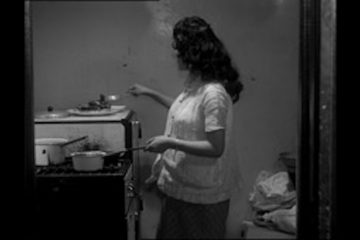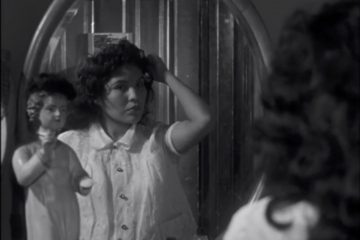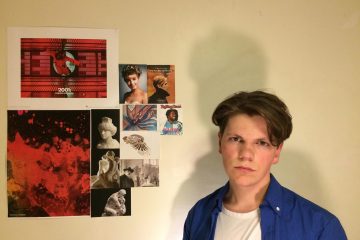In her seminal novel, The Second Sex (1949), Simone De Beauvoir wrote of the ‘fundamental characteristic of woman: she is the Other at the heart of a whole whose two components are necessary to each other’ (9). This subjugation and othering of women is reflected in the cinema, in general, and in this short sequence from Kent Mackenzie’s The Exiles (1961).

The film follows Yvonne (Yvonne Williams) as she returns from a shopping trip and enters her house. Within the house, the men’s presence is given prominence and Yvonne is marginalized in the background. As Homer, in search of a cigarette, passes the doorway leading to the kitchen he pauses, assessing Yvonne preparing a meal. The camera slows briefly as it pans over Yvonne but doesn’t stop; she remains in the back of the frame, out of focus, merely a footnote in Homer’s search (fig.1). The mise-en-scène here constructs Yvonne as an afterthought, merely a background character who is not worth attending.
This gendered gaze continues throughout this scene. When the camera does finally focus on Yvonne she is still subjugated within the frame. Although she may be central within the shot, she is a small figure within it; seen through a doorway. The doorway creates a frame within a frame as a way of signalling how trapped she is within her environment (fig. 2). This idea of Yvonne as trapped within the house with Homer and the men is consistent with the choice Yvonne ruminates on throughout the film: whether or not to leave Homer and the others. As the mise-en-scène creates the sense of Yvonne being trapped within the frame, it also suggests that within the male-run house she is a negligible figure or object.

As she cooks, Yvonne is seen largely in long shot whilst the men, who do little more than smoke and chat, are mostly seen in medium and closeup shots. Within this sequence it is the men, and by extension the implied male viewer, who is ‘structured as its centre, as the dominant and empowered figure, and thus reinforc[ing] patriarchal hegemony’ (Benshoff and Griffin, 239). Whilst Yvonne may narrate the sequence and criticise her marginalization, the mise-en-scène affirms the male gaze and as a consequence male power.

Later, Yvonne is seen combing her hair in the mirror. The view of her reflection is partly obscured by the placement of a doll in front of it (fig. 3). By arranging Yvonne’s reflection next to the doll, the image compares her to an idealized feminine figure (one that entails a passive beauty). Indeed, Benshoff and Griffin write that within film ‘”real” women remain marginalized while the “image” of women remains objectified’ (244). This view of Yvonne in the film becomes a sad truth as this is her only appearance in the scene without a man appearing or obstructing her in the frame; but even here she is not free. De Beauvoir writes that ‘man defines woman, not in herself, but in relation to himself: she is not considered an autonomous being’ (5-6). Indeed, within Homer’s domain, Yvonne, in the eyes of the men and thus the camera, has become akin to an object.
Up until this sequence within the film, the camera and narrative have followed and focused almost exclusively upon Yvonne. However, when she enters the house she enters a male domain and becomes their other. If mise-en-scène ‘encompasses both what the audience can see, and the way in which we are invited to see it’ (Gibbs, 5) then we can see how Yvonne becomes a male object through the male gaze. Within the house, the frame continually makes Yvonne smaller or out of focus or hemmed in before finally, explicitly, comparing her to an object, and suggesting some complicity in this objectification. The sequence corroborates Benshoff and Griffin’s view that ‘it is a fundamental ideological tenet of patriarchy that men and masculinity are privileged over women and femininity [and] Hollywood film has always privileged men and male roles over women and female roles’ (213). As an independent film The Exiles may seek to propose an alternative to the traditionally male gaze yet this analysis has shown how its mise-en-scène retains many of the trappings of the patriarchal Hollywood cinema.
References
Benshoff, M. and Griffin, S. America on Film: Representing Race, Class, Gender, and Sexuality at the Movies. New York: Wiley-Blackwell, 2009.
De Beauvoir, Simone. The Second Sex [1949]. trans. Borde, C. and Malovany-Chevallier, S. London: Vintage, 2011.
Gibbs, J. Mise-en–Scène: Film Style and Interpretation. New York: Wallflower Press, 2002.

Guy Edbrooke Pullen is a BA Hons English and Film student at QMUL. From Wimborne, Dorset, he writes for CUB Magazine and enjoys bouldering and cycling in his spare time. He plans to work in film journalism or film distribution.
Please obtain permission before redistributing. Copyright © 2018 Guy Pullen